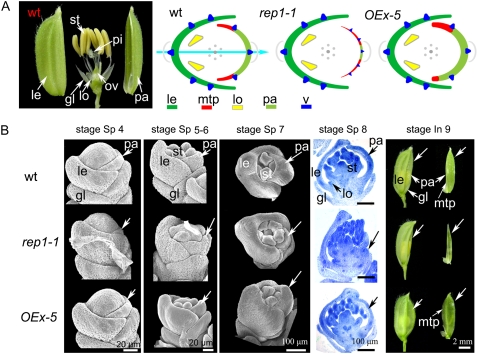Figure 1.
Comparison of flower development in wild-type rice (9522 variety), rep1, and OEx-5 (REP1OEx line 5). A, Wild-type rice florets have six stamens, which grow actinomorphically in one whorl, surrounding one pistil in the center of the flower, whereas the outer and second whorl organs, including lodicules, lemma, and palea, grow zygomorphically along the lemma/lodicules to palea axis according to their organ identities and position. The flower diagrams show the relative position of different organs, with identities indicated by colors and shapes: lemma in dark green and curved; palea in pale-green; mtp in red and curved; lodicule in yellow and triangular; and vascular tissue as dark blue triangles. The floral zygomorphy along the Le/Pa axis, as defined by the different types of organs, is indicated by a sky-blue arrow. B, Compared to that of wild type, the rep1-1 palea development course is significantly retarded, while the mtp cells were overdifferentiated asymmetrically in OEx-5 (arrows). Abbreviations not defined in text: gl, empty glume; le, lemma; lo, lodicule; ov, ovary; pa, palea; pi, pistil; st, stamen; v, vascular bundle.

